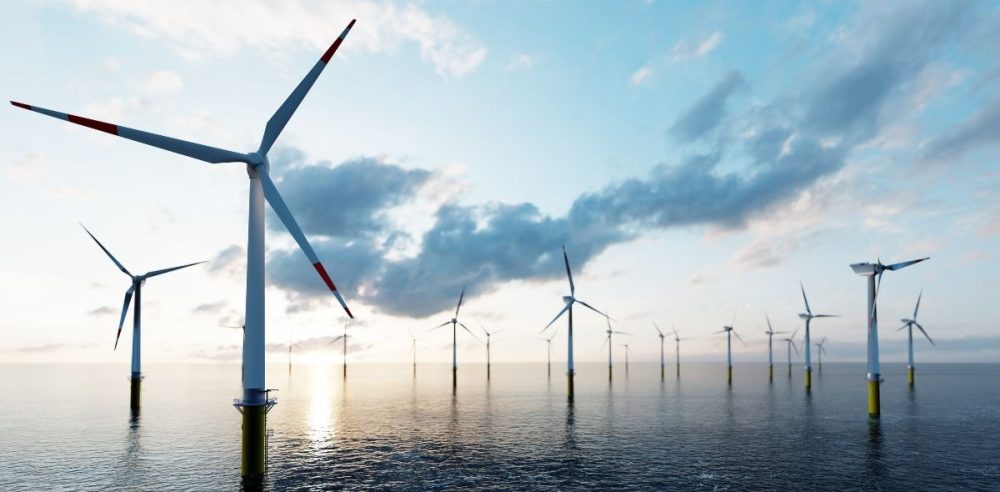While offshore wind in Texas may not be on the ballot this election, the presidential campaigns suggest that its future depends on the voters’ choices.
“They say that the [offshore wind turbines] drives ’em crazy. You know it’s a vibration because you have those things that 50-story building,” former President Donald Trump said in a viral moment from his recent interview with Joe Rogan. “The wind is rushing. The things are blowing. It’s a vibration and it makes noise.”
“I wanna be a whale psychiatrist. It drives the whales fricking crazy. And something happens with them, but for whatever reason, they’re getting washed up onshore and you know, they’re ignored by these environmentalists. But they don’t talk about it,” continued Trump.
Trump’s comments referenced the increase of whale beachings along the northeast coast after major offshore wind projects were constructed.
The National Oceanic and Atmospheric Administration publicly denies any connection between the phenomena and offshore wind. However, the National Marine Fisheries Service quietly raised concerns during the public comment period on a developing offshore wind project near south Texas that sound traveling through water could “harass” Rice’s whale, a variety of whale that inhabits Texas’s gulf.
The Biden-Harris Administration frequently highlights several offshore wind projects as major achievements and has promised to “[Advance] Offshore Wind off Every Coast.”
I support a Green New Deal. Climate change is an existential threat to all of us, and we have got to deal with the reality of it.
— Kamala Harris (@KamalaHarris) January 29, 2019
While senator, Vice President Kamala Harris posted on X her support for the Green New Deal, a plan that would’ve likely included major offshore wind projects. She has not shown any signs of changing her approach to this energy policy if she is elected president.
This comes as the Vineyard Wind offshore wind project near Nantucket, Massachusetts, has been recently surrounded by disaster.
The energy producer will soon be removing an undisclosed number of defective turbine blades after one mysteriously shattered last summer, The New York Times reported.
Moreover, press releases from Vineyard Wind have depicted the company’s painstaking cleanup and environmental analysis efforts to mitigate and assess the damage after the infrastructure failure.
No matter the outcome of these efforts, GE Vernova, the manufacturer and installer of the Vineyard Wind turbines, has reported a 20% decrease in orders and a flattening of revenues.
As Vineyard, arguably the most renowned project supported by the Biden-Harris administration, continues to face challenges, other projects in Texas remain uncertain.
The U.S. Department of the Interior has not announced the fate of the unsolicited lease sale request for the Hecate offshore wind project in south Texas.
DX reported that public comment on the project skewed negatively with various stakeholders, including commercial associations and federal agencies, as concerns were raised about dangers to East Texas’s shrimping industry and potential harm to coastal life.
Simultaneously, other projects, like the LA-TX offshore wind project near the coast of Port Arthur, have raised similar objections. Additional concerns focus on how BlackRock could be expanding its foothold in Texas energy at a time when the company is battling with Lone Star State agencies about its alleged discrimination against oil and gas producers, DX reported.
Nevertheless, the Biden-Harris administration has heralded the Port Arthur project as part of its plan to develop 730,000 aquatic acres into a power system that will produce 30 gigawatts by 2030. It has also called the offshore wind site a jobs creator and part of a transition to “clean energy.”
Other projects in the Texas Gulf have been axed or indefinitely stalled because of a lack of commercial interest.
Both Harris and Trump have made energy part of their platform.
Harris’ campaign website has alluded to a sweeping plan to “Lower Energy Costs and Tackle the Climate Crisis [capitalization in original].”
Her website lacks specifics on the plan, although it gives the impression that it will favor alternative energy production. The vagueness of her vision for energy production resembles her several about-faces on issues like fracking.
Trump frequently highlights energy production and describes an all-of-the-above energy policy, meaning he wants to increase every type of energy production.
Historically, Trump has not appeared to be fond of offshore wind. Trump has criticized the form of energy production on numerous occasions and has sued to prevent the projects near his golf courses overseas.
Yet, in a twist of history, the Trump administration once flaunted its development of offshore wind projects, including executing the initial auction for part of the aquatic acreage that eventually became Vineyard Northeast, part of the larger group of Massachusetts-area Vineyard Wind projects.
“I’m very bullish on offshore wind, and harnessing this renewable resource is a big part of the Trump administration’s Made-in-America energy strategy,” Trump’s Secretary of the Interior Ryan Zinke said in 2018.
However, in December 2020, the outgoing Trump administration sought to halt the Vineyard project, with the project only surviving because of the incoming Biden-Harris administration.
Despite the shifting perspectives, a clear contrast has been established for the 2024 election; now, voters must choose.


